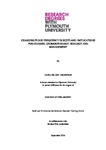CHANGING FLOOD FREQUENCY IN SCOTLAND: IMPLICATIONS FOR CHANNEL GEOMORPHOLOGY, ECOLOGY AND MANAGEMENT
| dc.contributor.supervisor | Gilvear, David | |
| dc.contributor.author | Thompson, Fiona Hilary | |
| dc.contributor.other | Faculty of Science and Engineering | en_US |
| dc.date.accessioned | 2017-08-04T10:01:39Z | |
| dc.date.issued | 2017 | |
| dc.date.issued | 2017 | |
| dc.identifier | 10478545 | en_US |
| dc.identifier.uri | http://hdl.handle.net/10026.1/9667 | |
| dc.description.abstract |
The effect of climate on the fluvial system has long been investigated due the significant impact it can have on a river’s hydrological regime and fluvial processes. In recent years this interest has increased as global changes in climate are expected to bring more frequent high magnitude flood events globally and to North West Europe in particular. Despite the knowledge that the frequency and magnitude of floods is to increase, less is known about the geomorphological implications of this for river channels and where channel instability is likely to occur at both the river network and national scale. This is certainly the case in Scotland where increased flooding is expected and large floods have been abundant over the last two decades. To manage Scottish river catchments effectively in the future, in terms of hazard mitigation and nature conservation, river managers need to be able to predict not only how climate will impact flood magnitude and frequency in Scotland but the effect these changes will have on the internal dynamics of river channels in terms of erosion, sediment transport and deposition, and morphological dynamics. Such knowledge will ensure adequate measures are implemented to reduce fluvial risks to humans and to maintain and preserve valuable river habitats and linked species. In this thesis, several novel methods incorporating field, laboratory and GIS-based analysis, have been investigated as a means of predicting how climate change will affect channel stability in Scottish rivers and the implications of this for river management and river ecology. This includes (i) analysing the potential change in the frequency of geomorphologically-active flood flows with climate change; (ii) the use of stream power thresholds to predict changes in channel stability on a national scale with climate change; and (iii) using a Digital River Network developed using geospatial data to predict changes in the rate of bedload transfer and channel stability with climate change. Studies were undertaken on 13 different rivers across Scotland from north to south and east to west. vii As a case study of ecological implications, the thesis also examines how changes in habitat and stability of freshwater pearl mussels (Margaritifera margaritifera) may be altered by increased flooding. Predictions of the frequency of geomorphic activity, channel stability, rate of bedload transfer, and the stability of freshwater pearl mussel habitat with climate change are discussed along with the methods used to obtain these outcomes. The results all suggest an increase in the frequency and rate at which bedload is transferred through the river system and an increased frequency of flood flows resulting in greater channel instability. Morphological responses vary spatially with some river reaches experiencing greater increased erosion and transport potential than others. Climate change effects on the freshwater pearl mussel are: increased occasions of disturbance and transport downstream and the importance of specific populations in more stable environments for ensuring population recovery post flooding is highlighted. It is hoped that the methodologies developed for predicting changes in channel stability with climate change will provide useful screening tools to regulatory agencies which can be developed further to assist management decisions in the future which aim to reduce fluvial hazards and maintain good quality river environments for the species that inhabit it. The approaches used in this study allow for the identification of areas at high risk of morphological and ecological change, and the pro-active planning and management of sediment-related river management issues and nature conservation. | en_US |
| dc.description.sponsorship | Scottish Environmental Protection Agency | en_US |
| dc.description.sponsorship | Scottish Natural Heritage | en_US |
| dc.language.iso | en | |
| dc.publisher | University of Plymouth | |
| dc.rights | CC0 1.0 Universal | * |
| dc.rights.uri | http://creativecommons.org/publicdomain/zero/1.0/ | * |
| dc.subject | Freshwater Pearl Mussel | |
| dc.subject | Channel Stability | |
| dc.subject | Stream Power | |
| dc.subject | Climate Change | en_US |
| dc.subject.classification | PhD | en_US |
| dc.title | CHANGING FLOOD FREQUENCY IN SCOTLAND: IMPLICATIONS FOR CHANNEL GEOMORPHOLOGY, ECOLOGY AND MANAGEMENT | en_US |
| dc.type | Thesis | |
| plymouth.version | publishable | en_US |
| dc.identifier.doi | http://dx.doi.org/10.24382/1129 | |
| dc.rights.embargodate | 2018-08-04T10:01:39Z | |
| dc.rights.embargoperiod | 12 months | en_US |
| dc.type.qualification | Doctorate | en_US |
| rioxxterms.version | NA |
Files in this item
This item appears in the following Collection(s)
-
01 Research Theses Main Collection
Research Theses Main



